ON CAVING
SAMAR ISLAND GUIDE: EXPLORER JONI A. BONIFACIO TEL: 055-2512301
CELL:09192943865 / 09159903553
WEBSITE: www.bonifaciojoni.blogspot.com
ON CAVING
THE LANGUN-GOBINGOB CAVE
CALBIGA,SAMAR
OCTOBER 26-28, 2001
PARTICIPANTS:
1. JONI A. BONIFACIO TREXPLORE/ORGANIZER CATBALOGAN,SAMAR
2. TERESITA DOCABO TREXPLORE CATBALOGAN,SAMAR
3. AURORA ESTOLANO U.P. TACLOBAN CITY
4. RONNIE C. MURING USC-WRC CEBU CITY
5. JUAN PABLO YAO VISCA CEBU CITY
6. NAPARI,LUCIAW EDIM LSU KNANGA,LEYTE
7. JON GRACIANO G. RAFOLS LSU CEBU CITY
8. JHUN TY TREXPLORE CATBALOGAN,SAMAR
9. PAUL SARABILLO TREXPLORE CATBALOGAN,SAMAR
10. SARABILLO,JOHN C. TREXP0RE CATBALOGAN,SAMAR
11. RICKY J. BAUTISTA TREXPLORE CATBALOGAN,SAMAR
12. GLENDA BANTANG TREXPLORE CATBALOGAN,SAMAR
13. EKA TREXPLORE CATBALOGAN,SAMAR
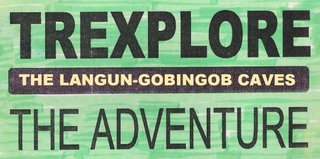
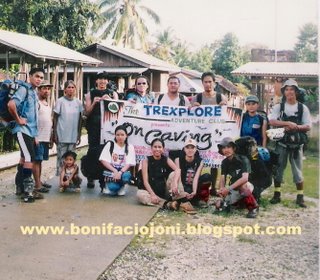
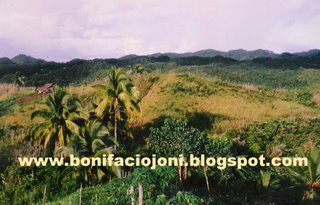
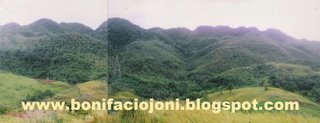








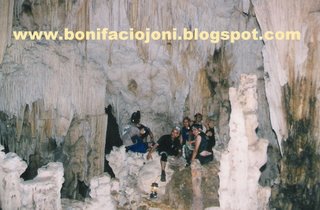










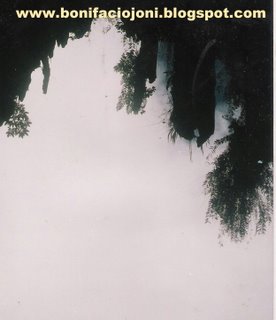
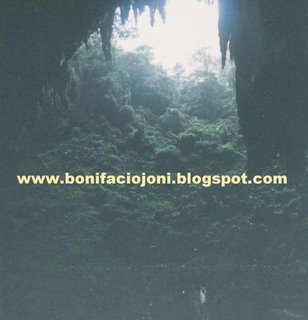


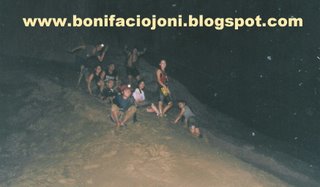
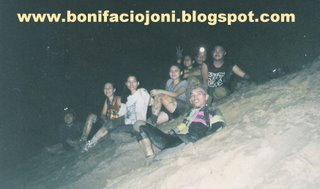



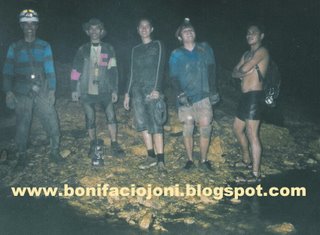
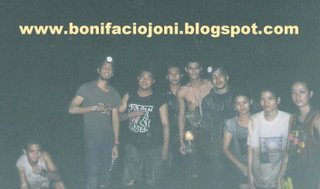
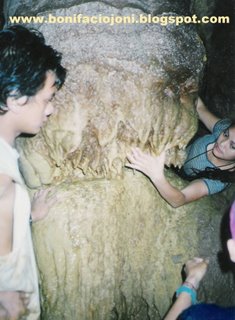


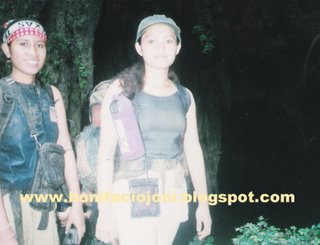

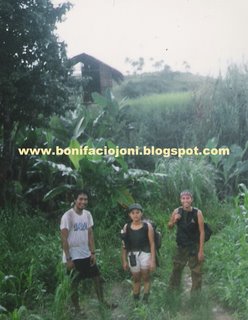
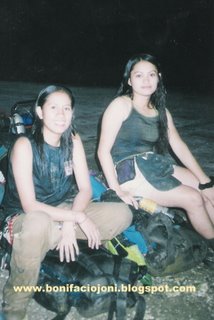



THE WONDROUS EXPERINCE OF EXPLORING COUNTRY'S BIGGEST "CATHEDRAL" CAVES
“Biggest Cathedral Cave in the World”
Just recently the TREXPLORE ADVENTURE CLUB a small tour group based in Catbalogan, Samar had initiated a three days and two night cave exploration. The group compose hardcore and neophyte climbers and spelunkers escorted about 14 all Filipino tourists to the world famous LANGUN-GOBINGOB CAVE in Brgy. Panayunan. Some 7 kilometers from Calbiga poblacion last October26-28,2001.
The visitor mostly from Cebu City and other cities in the Visayas were taken on a wild bumpy ride in old six wheel drive jeepney in a safari-like journey across the dusty expanse of the Japan-Philippine highway from the provincial capital of Catbalogan to the barangay. Panayuran where the hike begins.
The TREXPLORES guided the hands legs and eyes of the adventures to he peregrination inside the “second baggiest cathedral cave in the world that can undoubtedly accommodated about fifty commercial passenger planes put together side by side” one of its component sized as big a Araneta Coliseum. The 3 days-2 night crawling extreme rappelling descending on a 45 degrees vertical cliff and unlimited rives cruising inside the cave forced the team to take rest for every chamber’s activity.
The “spelunkers” namely GRENDA BANTANG, TERESITS DOCABO, JUN TY, PAUL SARABILLO, JHON SARABILLO,GRACE AND MICA could not help but be awed with its pristine and untarnished façade “this is for world class cathedral,” they said.
Plan environmentalist LUCIANO ED M NAPARI- OF Kananga Leyte JON GRACIANO RAFOLS, JUAN PABLO YAO of Cebu City where just excited when they saw the poster-invitation posted in a Habagat office in Cebu almost duetly agreed to say,” this place has a big potential but it hasn’t been exposed much.”
The Blindfish
Professional caver RONNIE MURRING of the free-launch caving club, who solely spent a day travel from his home town in Cebu City had the chance in his life to personally witnessed the CAECOGOBIUS CRYPTOPHTALMUS, the first hipogean “blindfish” found only the Philippines, and first gobinee known in the world, discovered in the karst cave of Calbiga, Samar. In 1987 by the Italian speleogists. The name originates from the local absence of any external trace of eyes. The presence of some pigmentation thin and tiny scales the deeply embedded eyes indicate that the adaptive process to the cave habitat is still underway. The Length of the “blindfish” is about 7 kilometers.
A discovery channel fan form the university of the Philippines – Tacloban City. Ms. AURORA N. ESTOLANO, who field the 3 days leave of absence in her rigid work just to explore the twelve cave systems remarked. “this could be a great proud of the Samareños in term of eco-tourism industry.”
It is also heartening to note that the local government of Calbiga, thought the leadership of the town mayor MELCHOR F. NACARIO had showed a strong determination to attract more and more international and local tourists so that its local tourism development program could broaden and siphon in cash and investment opportunities that could bolster the town’s bid to became the Waray Region’s alternative trade center.
Yes, it’s true that entering the cave in Calbiga is like going on a trek to the center of the earth Trexplorers compare the experience to the on unborn baby in side the mother’s womb. Total darkness envelops that long stretch of galleries and the huge mysterious underground chambers and rivers of the cave systems. Only dripping of calcium carbonate – laced water, the hurried flight of a few bats and explorers beat of heart could be heard.
The CALBIGA CAVE system occupies 2,968 hectares reaching the unsuspecting public domain under the towns of Paranas, Hinabangan and Pinabacdao in western Samar, and part of the province of Eastern Samar at its south section. It is composed of 12 cave system with wide underground spaces, unique rock formations and wild subterranean watercourses. Some of the biggest interconnecting chambers in this resource system are the Gobingod, Lagun, Teta and Bitong Mahangin Caves. Other names were still undocumented up to now.
According JONI A. BONIFACIO, who had been exploring the entire cave and building tourists since the year 1995, “the enormous size of the Langun chamber could easily fit three football fields”
“The documentation”
way back 1987, a group of Italian spelunkers explored the cave systems. The exploration dubbed “Samar 87,” resulted in the surveying and mapping of about 10 kilometers of the cave system. Explorer report revealed that the limestone outcrops stretched for 55 kilometers within an area of approximately 900 square kilometers. The highland measure an average altitude of 300-400 meters above sea level while mayor peaks reached some 600 meters.
Langun cave has galleries more than 50 meters high and 40 meters wide. The average size of each gallery is 15 meters in height and width. Its main chamber measures 270 meters long 160 meters wide at its largest point.
Gobingod cave, the most explored chamber has a rich forest growth wherein wild species such as cricket bats thrive. It also offers a big “Presidential Hall” with stalagmites, stalactites and stones of shapes and size.
Another cave known as Bitong Mahangin Cave is a swamp and has a single dry tunnel with bottoms rich in “forest- like” formations. Teta cave has muddy formatins of a hall with a “worm like” river around it and huge “chandlier- like” stalactites formations from the ceiling down to the floor of the cave.
CELL:09192943865 / 09159903553
WEBSITE: www.bonifaciojoni.blogspot.com
ON CAVING
THE LANGUN-GOBINGOB CAVE
CALBIGA,SAMAR
OCTOBER 26-28, 2001
PARTICIPANTS:
1. JONI A. BONIFACIO TREXPLORE/ORGANIZER CATBALOGAN,SAMAR
2. TERESITA DOCABO TREXPLORE CATBALOGAN,SAMAR
3. AURORA ESTOLANO U.P. TACLOBAN CITY
4. RONNIE C. MURING USC-WRC CEBU CITY
5. JUAN PABLO YAO VISCA CEBU CITY
6. NAPARI,LUCIAW EDIM LSU KNANGA,LEYTE
7. JON GRACIANO G. RAFOLS LSU CEBU CITY
8. JHUN TY TREXPLORE CATBALOGAN,SAMAR
9. PAUL SARABILLO TREXPLORE CATBALOGAN,SAMAR
10. SARABILLO,JOHN C. TREXP0RE CATBALOGAN,SAMAR
11. RICKY J. BAUTISTA TREXPLORE CATBALOGAN,SAMAR
12. GLENDA BANTANG TREXPLORE CATBALOGAN,SAMAR
13. EKA TREXPLORE CATBALOGAN,SAMAR












































THE WONDROUS EXPERINCE OF EXPLORING COUNTRY'S BIGGEST "CATHEDRAL" CAVES
“Biggest Cathedral Cave in the World”
Just recently the TREXPLORE ADVENTURE CLUB a small tour group based in Catbalogan, Samar had initiated a three days and two night cave exploration. The group compose hardcore and neophyte climbers and spelunkers escorted about 14 all Filipino tourists to the world famous LANGUN-GOBINGOB CAVE in Brgy. Panayunan. Some 7 kilometers from Calbiga poblacion last October26-28,2001.
The visitor mostly from Cebu City and other cities in the Visayas were taken on a wild bumpy ride in old six wheel drive jeepney in a safari-like journey across the dusty expanse of the Japan-Philippine highway from the provincial capital of Catbalogan to the barangay. Panayuran where the hike begins.
The TREXPLORES guided the hands legs and eyes of the adventures to he peregrination inside the “second baggiest cathedral cave in the world that can undoubtedly accommodated about fifty commercial passenger planes put together side by side” one of its component sized as big a Araneta Coliseum. The 3 days-2 night crawling extreme rappelling descending on a 45 degrees vertical cliff and unlimited rives cruising inside the cave forced the team to take rest for every chamber’s activity.
The “spelunkers” namely GRENDA BANTANG, TERESITS DOCABO, JUN TY, PAUL SARABILLO, JHON SARABILLO,GRACE AND MICA could not help but be awed with its pristine and untarnished façade “this is for world class cathedral,” they said.
Plan environmentalist LUCIANO ED M NAPARI- OF Kananga Leyte JON GRACIANO RAFOLS, JUAN PABLO YAO of Cebu City where just excited when they saw the poster-invitation posted in a Habagat office in Cebu almost duetly agreed to say,” this place has a big potential but it hasn’t been exposed much.”
The Blindfish
Professional caver RONNIE MURRING of the free-launch caving club, who solely spent a day travel from his home town in Cebu City had the chance in his life to personally witnessed the CAECOGOBIUS CRYPTOPHTALMUS, the first hipogean “blindfish” found only the Philippines, and first gobinee known in the world, discovered in the karst cave of Calbiga, Samar. In 1987 by the Italian speleogists. The name originates from the local absence of any external trace of eyes. The presence of some pigmentation thin and tiny scales the deeply embedded eyes indicate that the adaptive process to the cave habitat is still underway. The Length of the “blindfish” is about 7 kilometers.
A discovery channel fan form the university of the Philippines – Tacloban City. Ms. AURORA N. ESTOLANO, who field the 3 days leave of absence in her rigid work just to explore the twelve cave systems remarked. “this could be a great proud of the Samareños in term of eco-tourism industry.”
It is also heartening to note that the local government of Calbiga, thought the leadership of the town mayor MELCHOR F. NACARIO had showed a strong determination to attract more and more international and local tourists so that its local tourism development program could broaden and siphon in cash and investment opportunities that could bolster the town’s bid to became the Waray Region’s alternative trade center.
Yes, it’s true that entering the cave in Calbiga is like going on a trek to the center of the earth Trexplorers compare the experience to the on unborn baby in side the mother’s womb. Total darkness envelops that long stretch of galleries and the huge mysterious underground chambers and rivers of the cave systems. Only dripping of calcium carbonate – laced water, the hurried flight of a few bats and explorers beat of heart could be heard.
The CALBIGA CAVE system occupies 2,968 hectares reaching the unsuspecting public domain under the towns of Paranas, Hinabangan and Pinabacdao in western Samar, and part of the province of Eastern Samar at its south section. It is composed of 12 cave system with wide underground spaces, unique rock formations and wild subterranean watercourses. Some of the biggest interconnecting chambers in this resource system are the Gobingod, Lagun, Teta and Bitong Mahangin Caves. Other names were still undocumented up to now.
According JONI A. BONIFACIO, who had been exploring the entire cave and building tourists since the year 1995, “the enormous size of the Langun chamber could easily fit three football fields”
“The documentation”
way back 1987, a group of Italian spelunkers explored the cave systems. The exploration dubbed “Samar 87,” resulted in the surveying and mapping of about 10 kilometers of the cave system. Explorer report revealed that the limestone outcrops stretched for 55 kilometers within an area of approximately 900 square kilometers. The highland measure an average altitude of 300-400 meters above sea level while mayor peaks reached some 600 meters.
Langun cave has galleries more than 50 meters high and 40 meters wide. The average size of each gallery is 15 meters in height and width. Its main chamber measures 270 meters long 160 meters wide at its largest point.
Gobingod cave, the most explored chamber has a rich forest growth wherein wild species such as cricket bats thrive. It also offers a big “Presidential Hall” with stalagmites, stalactites and stones of shapes and size.
Another cave known as Bitong Mahangin Cave is a swamp and has a single dry tunnel with bottoms rich in “forest- like” formations. Teta cave has muddy formatins of a hall with a “worm like” river around it and huge “chandlier- like” stalactites formations from the ceiling down to the floor of the cave.

0 Comments:
Post a Comment
<< Home